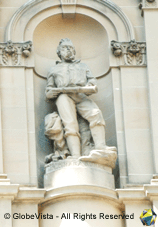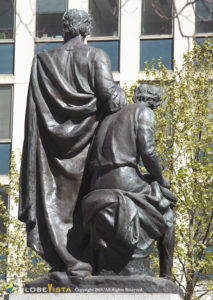Robert O’Hara Burke statue

Public Art: Robert O’Hara Burke statue
Sculptor: ©
Description: The sandstone carving of Robert O’Hara Burke, explorer, is one of 23 sandstone carved figures on the ledges of the Lands Department Building.
Date Unveiled: c1891
Location: The Robert O’Hara Burke statue is located in a niche on the Bridge Street facade of the Department of Lands Building, Bridge Street, Sydney, Australia.
So Who Was Robert O’Hara Burke? : Robert O’Hara Burke (6th May 1820 or 1821– c.28th June 1861) was an Irish soldier, police officer and eventual explorer in Australia. Unfortunately Burke will be most remembered for his ill-fated expedition with William John Wills in their attempt to be the first to cross Australia from south to north.
Burke was born in County Galway, Ireland, to James Burke, an officer in the British army and his wife, Anne. Following in his father’s footsteps he entered the Royal Military Academy at the age of 14 but when he failed his exams he toddled off to Belgium to continue his studies. At the age of 20 he joined the Austrian army and was posted in Italy. In 1848 he resigned from the Austrian army after debts and AWOL charges against him were dropped.
Burke next tried a career with the Irish police force (Irish Constabulary) in which he was extremely successful.
However, still restless, in 1853 he decided to migrate to Australia. He initially landed in Tasmania but soon decided to travel to Melbourne to join the newly established police force. In 1856, when he got word of his brother’s death in the Crimean War, Burke left Australia to enlist in the British Army however the war had ended by the time he arrived and promptly returned.
He continued in the police force and attended the Buckland Valley riots against the Chinese gold miners. However his world was about to change when he heard that the South Australian parliament was offering a £2,000 reward for the promotion of an expedition to cross the continent following John McDouall Stuart’s successful journey to the centre of Australia.
In June 1860, Burke was appointed to lead the Victorian Exploring Expedition with William John Wills, 17 men, 27 camels, and 23 horses.
In 1860 Robert O’Hara Burke, William John Wills, and a small party, left Melbourne in search of suitable grazing land between Central Australia and the Gulf of Carpentaria, on the request of the Victorian Government. The expedition left Melbourne in 1860 and travelled to Menindee on the Darling and then onto a depot at Cooper’s Creek.
 For the journey, the 19 men carried nearly 20 tonnes of supplies and equipment, including 6 tonnes of firewood! All of these provisions were carried on 6 wagons, but this proved to be a disaster. One wagon didn’t even make the start of the expedition whilst two others broke down at Essendon.
For the journey, the 19 men carried nearly 20 tonnes of supplies and equipment, including 6 tonnes of firewood! All of these provisions were carried on 6 wagons, but this proved to be a disaster. One wagon didn’t even make the start of the expedition whilst two others broke down at Essendon.
Before long it was realised that the wagons were simply slowing down the journey. Roads were by no means great and the wheels of the wagons struggled in the mud during the heavy rains.
Burke decided to load provisions onto camels to make the journey faster, despite some men having to now walk. The mood of the men was starting to disintegrate and it was soon clear that many were not happy with Burke’s decisions.
In October Landells (second in command) had had enough and resigned, followed shortly after by Dr Hermann Beckler (the surgeon). Wills was now promoted to second in charge.
With a great deal at stake (2000 pounds) Burke was growing ever so impatient with the slow progress of his team. As a result, when they arrived at Menindee, Burke decided that they should split into two teams. He and seven others would head to Coppers Creek as fast as possible and wait there, whilst the other team (with the majority of provisions) made their way slowly.
On reaching Cooper’s Creek Burke set up a depot and scouted around while waiting for the second team. It was intended that the party would wait until the summer months had passed before continuing their journey, but Burke grew impatient and decided to leave for the Gulf of Carpentaria in December.
Again the team split up with Burke, Wills, Gray, and King setting out for the Gulf while the remaining party, led by Brahe, stayed at the depot.
By February 1861 Burke, Wills, Gray and King had successfully made it to the Gulf of Carpentaria. On the way back, however, Gray fell ill and died. This left only a party of three to struggle back to the depot at Cooper’s Creek.
When they eventually arrived back to the depot they discovered that Brahe and his team had left. However, before leaving, Brahe had written a note to Burke and Wills telling of his group’s intentions. Brahe had buried the bottle under a tree and marked its location with the word “Dig” carved into the bark.
After Burke retrieved and read the note, he added a reply and placed it back in the same location for when Brahe returned. Burke, unfortunately, forgot to re-mark the tree to indicate that the team had returned and had read Brahe’s note. The three then continued on to Mount Hopeless in South Australia, rather than take the original route.
When Brahe returned to the depot there appeared to be no sign that the team had returned and so didn’t bother to check the bottle. Brahe then promptly left. Meanwhile Burke, Wills and King struggled to survive in the extreme conditions eventually forcing Wills to return once more to the depot.
Wills dug up the bottle and found it untouched and assumed that Brahe had not returned. He re-joined Burke and King only to find Burke near death. Within a few days both Burke and Wills had perished.
When news filtered back of Burke and Wills disappearance, six expeditions were sent to search for them. Two were commissioned by the Exploration Committee, three by the Royal Society of Victoria and one by the Government of South Australia.
King was eventually found in September by Alfred William Howitt after having been kept alive by Aborigines. The remains of both Burke and Wills were later retrieved and on the 23rd of January 1863. They both received a State Funeral and were interned at Melbourne Cemetery.